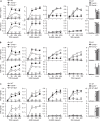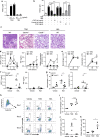TREM2 is a receptor for non-glycosylated mycolic acids of mycobacteria that limits anti-mycobacterial macrophage activation
- PMID: 33863908
- PMCID: PMC8052348
- DOI: 10.1038/s41467-021-22620-3
TREM2 is a receptor for non-glycosylated mycolic acids of mycobacteria that limits anti-mycobacterial macrophage activation
Abstract
Mycobacterial cell-wall glycolipids elicit an anti-mycobacterial immune response via FcRγ-associated C-type lectin receptors, including Mincle, and caspase-recruitment domain family member 9 (CARD9). Additionally, mycobacteria harbor immuno-evasive cell-wall lipids associated with virulence and latency; however, a mechanism of action is unclear. Here, we show that the DAP12-associated triggering receptor expressed on myeloid cells 2 (TREM2) recognizes mycobacterial cell-wall mycolic acid (MA)-containing lipids and suggest a mechanism by which mycobacteria control host immunity via TREM2. Macrophages respond to glycosylated MA-containing lipids in a Mincle/FcRγ/CARD9-dependent manner to produce inflammatory cytokines and recruit inducible nitric oxide synthase (iNOS)-positive mycobactericidal macrophages. Conversely, macrophages respond to non-glycosylated MAs in a TREM2/DAP12-dependent but CARD9-independent manner to recruit iNOS-negative mycobacterium-permissive macrophages. Furthermore, TREM2 deletion enhances Mincle-induced macrophage activation in vitro and inflammation in vivo and accelerates the elimination of mycobacterial infection, suggesting that TREM2-DAP12 signaling counteracts Mincle-FcRγ-CARD9-mediated anti-mycobacterial immunity. Mycobacteria, therefore, harness TREM2 for immune evasion.
Conflict of interest statement
The authors declare no competing interests.
Figures







Similar articles
-
Contribution of MINCLE-SYK Signaling to Activation of Primary Human APCs by Mycobacterial Cord Factor and the Novel Adjuvant TDB.J Immunol. 2015 Sep 1;195(5):2417-28. doi: 10.4049/jimmunol.1500102. Epub 2015 Jul 22. J Immunol. 2015. PMID: 26202982
-
TREM2 Promotes Immune Evasion by Mycobacterium tuberculosis in Human Macrophages.mBio. 2022 Aug 30;13(4):e0145622. doi: 10.1128/mbio.01456-22. Epub 2022 Aug 4. mBio. 2022. PMID: 35924849 Free PMC article.
-
C-type lectin receptor dectin-3 mediates trehalose 6,6'-dimycolate (TDM)-induced Mincle expression through CARD9/Bcl10/MALT1-dependent nuclear factor (NF)-κB activation.J Biol Chem. 2014 Oct 24;289(43):30052-62. doi: 10.1074/jbc.M114.588574. Epub 2014 Sep 8. J Biol Chem. 2014. PMID: 25202022 Free PMC article.
-
Non-pathological roles of microglial TREM2/DAP12: TREM2/DAP12 regulates the physiological functions of microglia from development to aging.Neurochem Int. 2020 Dec;141:104878. doi: 10.1016/j.neuint.2020.104878. Epub 2020 Oct 10. Neurochem Int. 2020. PMID: 33049336 Review.
-
The role of Syk/CARD9-coupled C-type lectin receptors in immunity to Mycobacterium tuberculosis infections.Clin Dev Immunol. 2010;2010:567571. doi: 10.1155/2010/567571. Epub 2011 Jan 9. Clin Dev Immunol. 2010. PMID: 21274433 Free PMC article. Review.
Cited by
-
In Situ Sprayed Biotherapeutic Gel Containing Stable Microbial Communities for Efficient Anti-Infection Treatment.Adv Sci (Weinh). 2023 Feb;10(4):e2205480. doi: 10.1002/advs.202205480. Epub 2022 Dec 7. Adv Sci (Weinh). 2023. PMID: 36479844 Free PMC article.
-
Orientia tsutsugamushi Infection Stimulates Syk-Dependent Responses and Innate Cytosolic Defenses in Macrophages.Pathogens. 2022 Dec 29;12(1):53. doi: 10.3390/pathogens12010053. Pathogens. 2022. PMID: 36678402 Free PMC article.
-
Trem2 deficiency impairs recovery and phagocytosis and dysregulates myeloid gene expression during virus-induced demyelination.J Neuroinflammation. 2022 Nov 4;19(1):267. doi: 10.1186/s12974-022-02629-1. J Neuroinflammation. 2022. PMID: 36333761 Free PMC article.
-
Deletion of Card9 eliminates the detrimental facets of mycobacterial adjuvants.Heliyon. 2024 Sep 19;10(19):e38139. doi: 10.1016/j.heliyon.2024.e38139. eCollection 2024 Oct 15. Heliyon. 2024. PMID: 39386804 Free PMC article.
-
BAY61‑3606 attenuates neuroinflammation and neurofunctional damage by inhibiting microglial Mincle/Syk signaling response after traumatic brain injury.Int J Mol Med. 2022 Jan;49(1):5. doi: 10.3892/ijmm.2021.5060. Epub 2021 Nov 9. Int J Mol Med. 2022. PMID: 34751408 Free PMC article.
References
Publication types
MeSH terms
Substances
LinkOut - more resources
Full Text Sources
Other Literature Sources
Molecular Biology Databases

